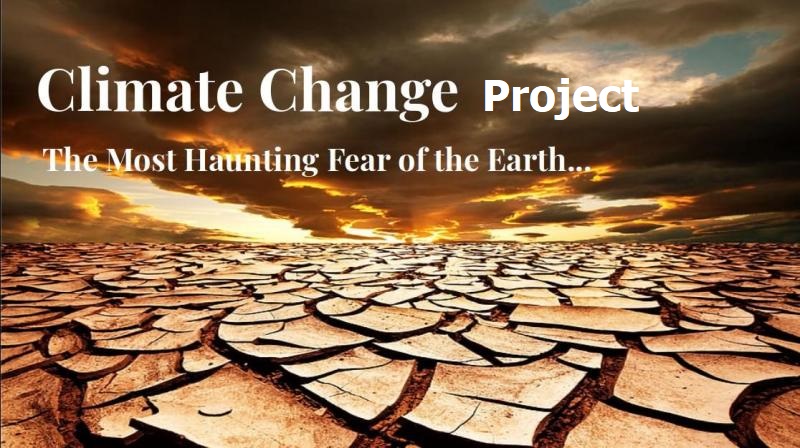Disaster Management Project on climate change: How to go for it?
Disaster Management Project on climate change is a popular topic in schools and colleges all over the world. Students reading Science, Social Science, Engineering, or Medical, anyone or everyone may have to complete a project on climate change. This is because climate change has become a global concern over the last few decades and is affecting life on Earth in various ways. In this project, we will focus on various impacts of climate change on the ecosystem. This will help you in completing your project on climate change. So, let us begin.
Five Things You Must Include In Your Project On Climate Change
While doing this project, you will face many difficulties. But, these difficulties of today will make you learn. You will develop 21st Century Skills which will make you capable of facing any disaster. While doing the project on Disaster Management, students set goals, exchange ideas and information, collaborate with others, and then share their work.
Project On Climate Change: How to go for it?

GUIDELINES FOR SUBMITTING THE PROJECT
1. Use A 4-size bond paper.
2. Project should be handwritten.
3. collect relevant newspaper clippings, maps, charts, drawings, tables, etc.
4. Each illustration should be supported with a write-up/relevance to the topic.
5. The cover page should have the topic in bold letters along with your name, and roll number.
6. Avoid using plastic covers/whiteners etc.
7. Use a hard bound cover file or get your project spiral bound.
Design the cover page On Climate Change
The very first thing which every student must do is to design a cover page.
There is no harm in taking ideas from the internet.
See hundreds of cover page designs.
Take note of good images, the way the title is written, border design, etc.
Once you are done, you have got enough ideas.
Now sit and design an innovative cover page.
Don’t copy from anywhere. Invest time, not money.
Try to use waste materials. Show it to your family members.
Watch their response and comments.
Design another cover page if not satisfied.
Now compare both designs.
See which design is covering all the aspects of your topic.
Finalize the one that is more attractive and unique. Your cover page is ready.
Do not forget to write your Name, Class, Sec, and Roll No.
See that your topic is on the cover page in clear and bold handwriting.
Page No.2 – Write down the Acknowledgement
After designing the cover page, now move on to the next page.
Generally, on the second page, you acknowledge your school, Principal and your subject teacher, parents, etc.
You must not forget the contribution of anyone who helped you in completing the project.
Here is a sample for your reference.
ACKNOWLEDGEMENT (Write at the center)
I would like to express my special thanks of gratitude to my Principal (Name) as well as my Teacher (Name) who gave me the golden opportunity to do this wonderful project on the topic “Project On Climate Change“, which helped me in enhancing my knowledge.
From the core of my heart, I would also like to thank everyone who supported me. I am overwhelmed by all humbleness and grateful to acknowledge all those who helped me to put these ideas well.
Equally grateful to my parents for giving me moral support and encouragement. With their able guidance and support, I could finalize this project within the limited time frame.
After completing this project, I feel motivated. Now I will be able to use my knowledge and skills during any type of Disaster more responsibly and sustainably.
Thanking you,
(Name)
Page No.3 Index page of your disaster management project on Climate Change
Page No. 3 will be your index page as given in textbooks. You have to mention the topics along with page no.
See example:
Sl. No. Topic Page No.
- Cover Page…………. 1
- Acknowledgment…. 2
- Index …………………. 3.
- Introduction to climate change.. 4.
- Climate change – who is responsible? 5.
- Effect of climate change… 6
- Role of UN to combat climate change…7
- Effect of climate change in India….8
- Rising sea level….9
- Global warming and climate change…10
- Role of a common man to combat climate change….11
- Conclusion…. 12
Page No.4 Introduction of your disaster management project on Climate Change
Your project begins from here.
Introduce your topic like “introduction to climate change”
Disaster Management and Project On Climate Change
On this page, you need to describe your topic in short. For example
Disaster Management aims to reduce or avoid potential losses from hazards.
It assures prompt and appropriate assistance to the victims of a Disaster and achieves a rapid and effective recovery.
It is the management of resources and responsibilities to lessen the impact of disasters.
A Brief History of Climate Change
When the normal temperature of a certain region changes, we call this phenomenon climate change. It is regarded as a change in the climate pattern due to internal and external forces. Some of the external forces are
changes in the orbit of the earth.
change in solar radiation.
earthquakes
volcanic eruptions and
plate tectonic movements.
Similarly, some of the internal forces are
carbon emissions
and the greenhouse effect
Page No. 5 Climate Change – who is responsible?
Your actual project begins on Page No. 5.
Our nature is based on the principle of balancing.
Therefore, When the balance gets disturbed, the effect can be seen on the climate.
Now, the question is who is responsible for climate change?
Some people believe that climate change is not caused by humans, but by natural causes.
While others believe that humans are the cause of climate change.
Smoke-emitting industries, vehicles running on roads, burning of fossil fuels, cutting of forests, etc are some of the human activities responsible for climate change.
All the above activities release greenhouse gas.
Carbon dioxide along with methane and nitrous oxide is mainly responsible for climate change.
After burning fossil fuels, greenhouse gases trap heat, which brings a change in the climate.
So, we can say that human activities are responsible for climate change.
Page No.6 Effect of Climate Change
Mahatma Gandhi said, “There is enough for everybody’s need but not enough for anybody’s greed”.
Today, man’s greed and deeds have not only harmed the environment but have disturbed the global climate.
Human activities such as deforestation, burning of fossil fuels, industrial wastes, pollution, etc. cause damage to the climate and ecosystem.
Due to this, many species of birds and animals got extinct or are on the verge of extinction.
Apart from this, climate change also has many adverse effects on the environment.
Some of them are –
- melting of glaciers
- increases the ocean water level
- declining forests and wildlife.
- Uneven rainfall.
- dying aquatic animals
- the rise in global temperature
This is just the beginning.
If proactive action is not taken, it will result in a big disaster.
The day is not far when humans will become extinct from the surface of the earth.
The Uttrakhand disaster is a current example in front of us.
Page No. 7 Role of the UN to combat Climate Change
The foundation of the effort to combat climate change is the UN Environment Programme (UNEP). We attack the climate crisis from different angles, including:
- promoting the switch to low- and zero-carbon emissions in important industries such as energy, forestry, buildings, agriculture, and construction.
- protecting and restoring natural ecosystems like forests, coral reefs, and peatlands
- eradicating the causes of degradation collaborating with governments, civil society, and the private sector to improve air quality and reduce emissions of short-lived climate pollutants.
- enabling communities to adapt to changing conditions by constructing resilient ecological foundations
- encouraging public engagement and behavior
- change through global campaigns and education initiatives
Disaster Management Project for Class 9 – Complete Guide
Page No. 8 Impacts of Climate Change On the Indian Economy
Agriculture:
Climate change can have a significant impact on India’s agricultural sector, which employs around 50% of the country’s population.
Extreme weather events such as droughts and floods can cause crop failures.
Furthermore, it can damage infrastructure, leading to reduced yields and increased food prices.
Water scarcity:
Climate change can lead to changes in precipitation patterns and increased evaporation, which can result in water scarcity in many regions of India.
Moreover, this can have a major impact on agriculture and also on hydroelectric power production.
Energy:
Climate change is likely to increase the frequency and severity of extreme weather events, which can damage energy infrastructure and lead to power outages.
Moreover, India’s power sector is also heavily dependent on coal, which is a major contributor to greenhouse gas emissions.
Coastal communities:
Rising sea levels caused by climate change could lead to increased flooding and coastal erosion in many parts of India, particularly in low-lying areas. Project On Tsunami: 13 Pages You Must Include In Your Disaster Management Project
This can have a major impact on coastal communities and their livelihoods.
Health:
Climate change can also have a significant impact on human health in India.
Increased temperatures and changes in precipitation patterns can lead to the spread of water-borne and vector-borne diseases.
Air pollution caused by the burning of fossil fuels is also a major health concern in India.
Page No. 9 Global Warming and Climate Change
Greenhouse gases:
Global warming is caused by the buildup of greenhouse gases in the atmosphere.
It is primarily carbon dioxide (CO2) from the burning of fossil fuels such as coal, oil, and natural gas.
Moreover, these gases trap heat from the sun, causing the Earth’s temperature to rise.
Temperature rise:
The Earth’s average surface temperature has risen by about 1.1 degrees Celsius since the late 1800s.
With the majority of warming occurring in the last few decades.
This warming has led to changes in climate patterns, including more extreme weather events and rising sea levels.
Climate change impacts:
Climate change can have a wide range of impacts on natural systems, economies, and human communities.
These impacts can include more frequent and severe heat waves, droughts, and storms, as well as rising sea levels, which can lead to coastal flooding and erosion.
Mitigation and adaptation:
To address the issue of global warming and climate change, it is important to both mitigate the causes of climate change and adapt to its impacts.
Mitigation involves reducing greenhouse gas emissions through the use of renewable energy, energy efficiency, and carbon capture technologies.
Adaptation involves taking steps to prepare for and cope with the impacts of climate change, such as building sea walls to protect against coastal flooding and improving water management.
Page No. 10 Role of a common man to combat climate change…
Individual actions can play a significant role in combating climate change. Here are a few ways the common man can make a difference:
Reduce energy consumption:
One of the most effective ways to reduce greenhouse gas emissions is to use less energy.
This can be done by using energy-efficient appliances, turning off lights and electronics when they are not in use, and using public transportation, biking, or walking instead of driving.
Use Renewable energy:
Using renewable energy sources such as solar, wind, and hydropower instead of fossil fuels can also help to reduce emissions.
Reduce, Reuse, Recycle:
Reducing waste and recycling can also help to combat climate change by preventing greenhouse gases from being released from landfills.
Support sustainable products:
Support products that are produced in an environmentally friendly way, and avoid products that have a large carbon footprint.
Be informed:
Stay informed about climate change and the actions that can be taken to combat it.
Encourage others to take action and support policies and regulations that promote sustainability.
Plant Trees:
Planting trees and other vegetation can help to remove CO2 from the atmosphere and reduce the impacts of climate change.
Page No. 11 Conclusion On Climate Change
In conclusion, climate change is a pressing global issue that requires immediate action. It is caused by the buildup of greenhouse gases in the atmosphere and is leading to changes in climate patterns, including more extreme weather events and rising sea levels. The common man can play an important role in combating climate change through actions such as reducing energy consumption, using renewable energy, reducing, reusing, and recycling, supporting sustainable products, being informed, and planting trees.
It’s important to note that, while individual actions may not have a large impact, when combined with the actions of others, they can make a big difference in the fight against climate change. It’s crucial for all of us to take immediate action to combat climate change and secure a sustainable future for generations to come.
You may be interested in
11 Point Project On Consumer Awareness
Disaster Management Project for Class 9 – Complete Guide
How To Complete Your Industrial Disaster Management Project In Just 3 Days?
Five Things You Must Include In Your Project On Climate Change





0 Comments